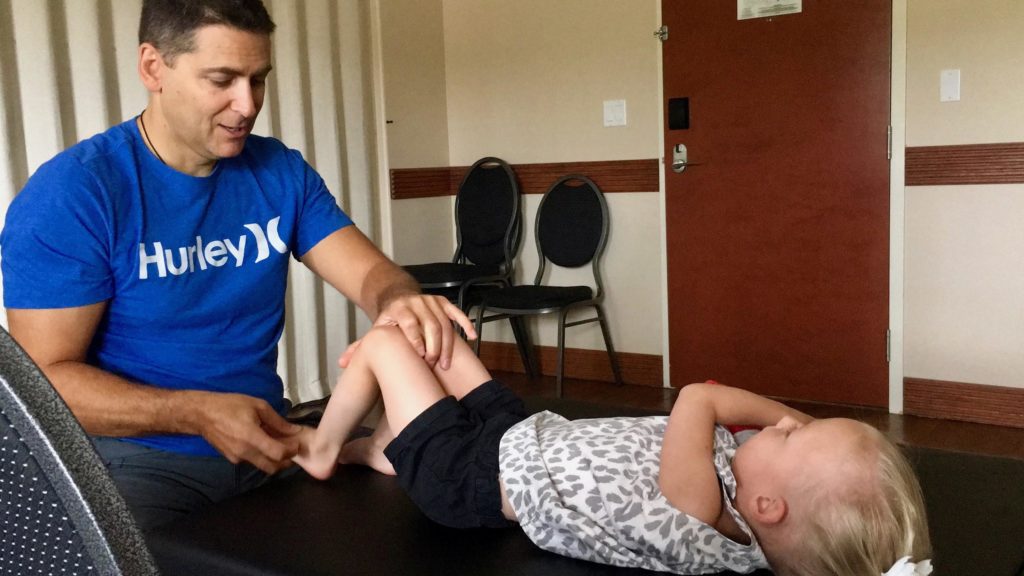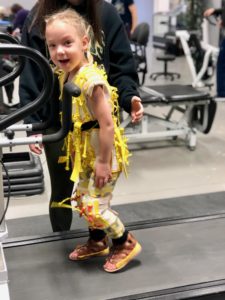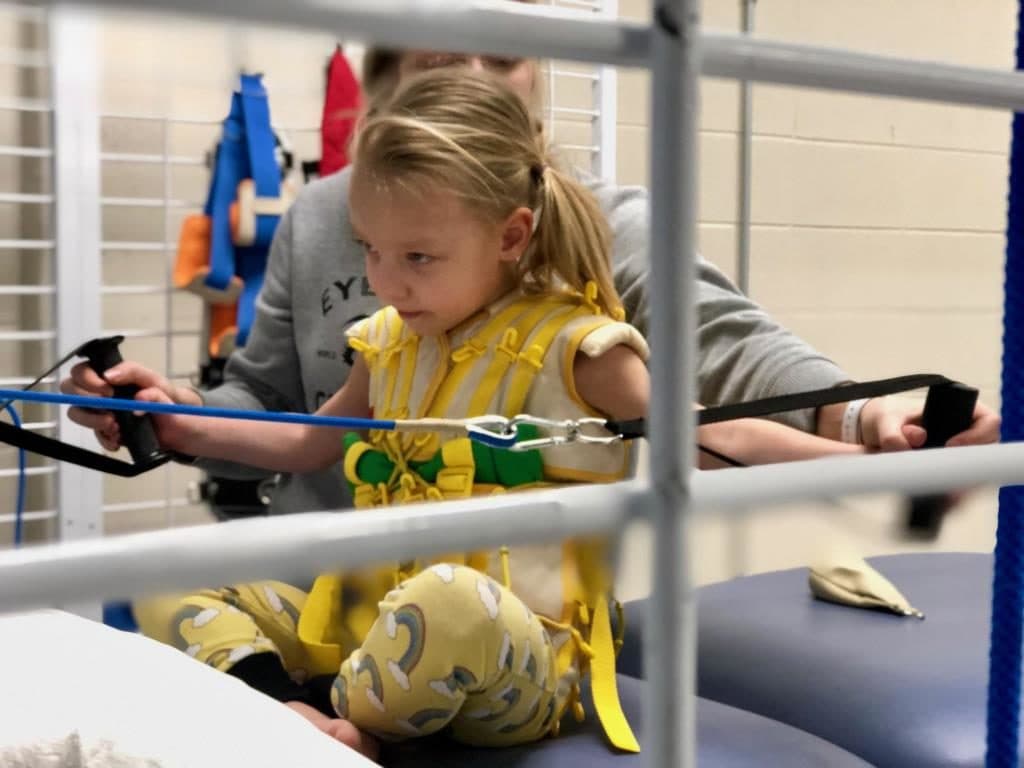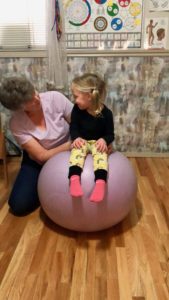Beyond Traditional Therapies For One And All
Being an athlete myself for most of my life, loving science and math for as long as I can remember, and growing up in a family that did whatever it takes no matter what has definitely contributed to my strong advocacy for Breanna’s treatments and how I view her future. Luckily I married a man who is on the same page as me. From our experience with receiving Breanna’s diagnosis, there isn’t someone who takes you on to the next step. It’s like you and your child are held over the edge of a deep body of water and both dropped in at the same time. You’re left to save yourself and your child without extra measures while trying to get to safety. I feel that my past and passion for learning has at least partially helped set us up for success. It also helps when you meet people along the way who are similar in tenacity and it makes research time far more efficient!
When you are aware of what is possible with neuroplasticity and rehabilitation and you begin your therapy journey post diagnosis with the traditional physiotherapy and occupational therapy, you wonder what the heck you got yourself into. You scream to yourself, “there has to be more!” This isn’t to say that we haven’t had amazing therapists along the way: we have adored them but they just haven’t offered hope and progress to living with a better quality of life. They are also limited to what they can offer and how they can offer treatment. (Who’s at fault here?…That’s a whole other topic haha) Many families are finding what works are the treatments and therapies that are non-traditional or alternative, but not without scientific evidence to go along with them! We were fortunate enough to meet Cat from Bangel PR through Instagram a couple of years ago (seriously… it’s like special needs moms unite on Instagram which is amazing) and she opened up this whole new world of treatment for Cerebral Palsy for us. Our conversations sent me on a whole new search path and I’m so thankful. It’s a mission now to do the same for others as Cat was able to do for us.
Our brains are fascinating and a Cerebral Palsy brain even more so while equally frustrating. Let’s get two things straight…there is no cure for Cerebral Palsy and it is not a progressive diagnosis (it will not get worse…or better for that matter). This being said, as a person with CP ages, the condition takes a toll on their body and other issues, for example arthritis, begin to develop making it seem like a condition that is getting worse. The brain injury, however, has remained the same (unless there are other factors/diagnoses to consider). Finding treatments for Breanna’s Cerebral Palsy is not with the hopes of finding an unattainable cure but rather to help her live a better quality of life with greater functionality and less pain.
With different treatments and therapies, come time commitments, financial commitments, brain boost diets, travel, and loads of patience. Ohhhh the patience! Sometimes the progress is huge and sometimes super small, but everything counts! There is also the struggle that everyone is different and no one responds the same way to treatment so it is basically a guessing game as to what may work and what won’t for that particular person. A second struggle is locating the therapies you want to try and realizing that nothing is universal in the world of Cerebral Palsy and rehab therapy. What is mainstream and “just another tool” in another country is available at only a select few locations in Canada and the United States for example. The powerful therapies that we have found effective and life changing are ones that we’ve had to commit both time and money to but have been so worth it. So what are these cool therapies?!
- ABM (or the Anat Baniel Method).
What is it?
ABM is a method that facilitates the creation of neural pathways through gentle movement while a person’s ‘learning switch’ is turned on. With the creation of these neural pathways, what was once a limitation can become a possibility and a reality. What the brain didn’t know existed, it can now discover and map! An example of this is that often with Cerebral Palsy, the affected person’s brain doesn’t know that he/she has two legs. ABM can bring awareness to that ‘missing’ leg, allow a person the ability to map the movement of both legs, and use them functionally. ABM is not limited to focus on physical gross and fine motor skills either: it has allowed people who were unable to speak and communicate the ability to do so, kids struggling in school with a certain subject the ability to experience success, and so much more.
How is it done?
I find ABM a difficult therapy to describe but to me it looks like super gentle adjustments through small movements, sometimes accompanied by sounds, guided by an ABM practitioner that brings awareness to any part of the body with an active learning switch.
Who can benefit from ABM?
Something super cool is that ABM doesn’t just limit itself to treating people with a wide range of disabilities; it is also an incredible way to maximize potential in fitness, professional skills, vitality, and living life to the fullest. Anyone, no matter the age, can benefit from bringing awareness to parts of our bodies that we use everyday for optimal use and to parts that we’ve forgotten due to a lack of use.
How often is it done?
Most effectively, it is done in “intensives” meaning multiple times a day for several days, however, even single sessions can be effective. We have experienced the benefits to both. Results aren’t always immediate and they may take weeks to appear. They are powerful and may produce progress anywhere on the spectrum from very small to very large depending on the situation. Keep in mind that even those little changes are often cause for big celebration. Certain developments will remain and some will slowly revert. It is tricky to find a balance with how often ABM needs to be done to avoid going backwards or reverting and it varies for each individual depending on their situation. Often the reverting is due to the brain injury and lack of use.
What has ABM allowed Breanna to do?
Breanna’s very first day of ABM was a super emotional one. We watched her run for the first time…well run “properly”. Throughout her ABM intensives and for weeks after each one, ABM allowed Breanna to:
- Not require her AFOs (braces on her feet). How huge is that! Prior to ABM, she would trip over her toes due to tight hamstrings and calves (common with CP) and this was the reason for wearing her AFO braces. ABM helped her heels find the ground and put into practice the heel-toe movement. The more we have done ABM, the less the AFOs were needed and she now does not wear them at all.
- Side-sit and sit on her knees with feet under her via her own engagement. Prior to ABM, Breanna was a big ‘W’ sitter and her brain couldn’t actually figure out how to sit in other positions aside from criss-cross-applesauce and ‘W’ sit. It was amazing to find her side sitting and working on her core without needing to ask or physically put her in those positions.
- She is able to feel parts to her torso that she didn’t know existed and that she had two legs and two hips that can function independently. This helped with basically everything and allowed her body to move more fluidly and not in large chunks. Try turning a corner without your shoulders and hips moving independently from each other…not effective.
- Lay on each side comfortably. There are times when she can’t lay on a given side.
- Put her arms above her head and reach up.
- Experience more comfortable digestion.
- Better eye tracking.
Where can I find ABM?
There are ABM practitioners in Alberta (Sherwood Park and Calgary).
Best way to learn more:
Grab a copy of Anat Baniel’s Book ‘Kids Beyond Limits’and check out her website. There are also powerful YouTube videos you can watch. Each ABM practitioner usually has their own website or Facebook page as well that you can learn a lot from.

ABM in Sherwood Park, Alberta with Ed Dassie of New Connections Movement Works LLC.

ABM with Robyn Roper in Calgary, Alberta.

ABM with Chris Mealing of Active Mind Therapies in Moose Jaw, Saskatchewan.
- Therasuit®/Therasuit Method®
What is it?
The Therasuit®is an exercise device designed (and owned) by two physiotherapists who are also parents to a daughter with Cerebral Palsy. It is also the only device of its kind registered with the FDA. The Therasuit Method®is a personalised training program using the Therasuit®to gain functional progress. The origin of the super suit itself is quite interesting. The concept of today’s Therasuit®originates from the spacesuits worn by astronauts to prevent muscle loss and other negative effects due to a lack of gravity.
The Therasuit®is comprised of a cap, vest, shorts, arm pads, kneepads, and shoes/shoe attachments. Through the elastic band style cords (we call them muscles) attached in strategic places on the suit, a person can “improve and change proprioception (pressure from the joints ligaments, muscles), reduce patient’s pathological reflexes, restore proper patters of movement, and load the entire body with weight.” (Suittherapy.com) When the suit was put on my own body at ReYu, as Nancy (the lead neuro exercise specialist) put on the cords in certain spots, I had no choice but to engage those muscles. It was a very cool feeling to have so many muscles in so many areas engaging at once to provide the neuro feedback.
The Therasuit®can provide so many benefits, which include but are not limited to: retrains the central nervous system, provides stabilization, normalizes muscle tone, aligns the body, provides dynamic correction, normalizes gait pattern, influences the vestibular system, improves balance coordination and body & spatial awareness, decreases uncontrolled movements, supports weak muscles while providing resistance to strong muscles, and provides head and trunk support to improve speech production and fluency.
Who can benefit from it?
This is another device/therapy/method that is not restricted to persons with disabilities. If I could include the Therasuit®in my life, I would! This being said, it’s most beneficial for a person with neuro-motor disorders.
How often is it done?
This method varies depending on the situation but is often done through intensives (extended period of time during the day for multiple days in a row) but can also be used as an addition to current therapeutic treatments or become routine in one’s daily life if used at home. Breanna is currently using it once or twice a week. This is also another therapy where the results aren’t always immediate: it could be weeks before things start to connect.
Where can I find the Therasuit?
Right here in Edmonton, Alberta at ReYu Paralysis Recovery Centre! Initially in December, we travelled to First Steps Wellnessin Regina, Saskatchewan, as this was the closest facility to us that offered the Therasuit®. We were there for a month long intensive where Breanna wore the Therasuit® everyday among other treatments as well (mainly Reflex Integration-MNRI, activity based training, and strength training). The results from this intensive were incredible and when we returned home, the super suit was on order at our home base, ReYu! The Therasuit Method® is offered all over the world, gaining in popularity in a lot of countries and mainstream therapeutic option in others.
What has the Therasuit done for Breanna:
When a person first puts on the Therasuit®, it can be quite overwhelming and require a slow adjustment period where you increase the time in the suit by a little bit each time. Once Breanna was adjusted to it, we started to notice things happening such as:
- She could get up from sitting or kneeling on the ground without needing to use her hands. This change gave her self-confidence a huge boost!
- Balancing and hopping on one foot (both feet!).
- Use her hands more effectively when holding a utensil.
- Fluidity in printing and drawing had improved immensely.
- Endurance increased immensely for all activities.
- Going up and walking down the stairs without holding on to anything.
- Confidence to jump up and down stairs without holding on to anything.
- Entire body strength increased.
- Breathing was less laboured due to increased core strength.
- Sensory overload was less. She was more open to feeling pressure on her body.
Best way to learn more:
Check out the Therasuit®website, YouTube, Instagram, and if you’re in YEG make sure to check out ReYu.

Therasuit® on treadmill at First Steps Wellness Center in Regina, Saskatchewan.

Therasuit® at ReYu Paralysis Recovery Center in Edmonton, Alberta.

Therasuit® at First Steps Wellness Center in Regina, Saskatchewan.
- Reflex Integration
What is it?
Reflex Integration is the process that our nervous system goes through to learn how to react/respond to certain stimuli. Our primitive reflexes either develop in utero or shortly thereafter in the neonatal phase. They have a schedule and some are to help us in utero, some prepare us for the birthing process, and some are to help us with both physical and emotional needs as we age (ex. Speech, feeding, breathing, rolling, stepping on something sharp, grip, grasp, problem solving, etc). As our bodies practice these responses we eventually integrate them and put them aside for when we really need them throughout our lives. An example of this is our fight or flight response- we practice our responses as babies and put the reflex aside for when we may need it in response to a stressful or traumatic stimulus. Unfortunately sometimes these reflexes do not integrate and remain active. Another example is for those people who skip the crawling stage and go straight to walking- there is often need to integrate a reflex later on when issues begin to present themselves. This is where we can see all kinds of issues arise whether in behaviours, school performance, response to stress, physical developmental delays, chronic pain, and more. Help is needed to integrate or re-integrate (depending on the situation) these reflexes. Often to be able to progress with certain desired therapies, reflex integration helps to have done first as certain reflexes can be the cause to slow progress in other areas.
How is it done?
Reflex Integration therapy can be done in a variety of different ways:
- MNRI (Masguatova Neurosensorimotor Reflex Integration) where a practitioner works on a person assisting them through sets of movements (sensory activation, motor activation, resistance activation) on a comfortable surface. MNRI has many levels and techniques that provide feedback but the main sections are Dynamic and Postural, NeuroTactile, NeuroStructural, Oral-Fascial, Archetype, Lifelong, and Trauma/Stress Recovery.
- Activity Based Integration where reflex integration is done through activities and movement, which help to create a more fun environment (definitely great for kids!)
- Quantum Reflex Integration using Cold Laser Therapy.
Who can benefit from Reflex Integration?
Once a reflex is integrated, we should not have to re-integrate. Super cool! This being said, life circumstances can change this. It is not limited to people with developmental delays and disabilities, however, unless there is a reason to re-integrate, it will not help the average person. The people who will see the most benefit from it are people who have developmental delays, brain injury, Dyslexia, ADD/ADHD, Autism, Sensory Processing Disorder, emotional instability, genetic disorders, chronic pain. If a child is having troubles in school whether it is in a particular subject, focus, or emotions, there is a strong possibility that there are reflexes that need integrating. Both Breanna and my son Collins are currently working on reflex integration and I know that for myself I have reflexes that need re-integration.
How often is it done?
Reflex Integration is another treatment that should be done in intensives; however, it is possible to work at it otherwise.
What has Reflex Integration done for Breanna and Collins?
- Breanna:
She was forever holding her toes in ‘foot grasp’. This is common with CP and a response to balance issues. After a few days or working on the foot grasp reflex, her toes continue to remain flat and out of grasp!
o Able to keep her arms straight more.
o Able to crawl and stay in the tabletop position on all fours.
o Better hand control and has begun to feel parts of her fingers that she has never felt before!
o Easier core activation.
o Coming out of fear paralysis and responds better to stressful stimuli.
o More feeling in her mouth/face, which assists with chewing, swallowing, and speaking. This has also reduced her sensory-seeking need to put things in her mouth.
o Eye tracking and better identification of how her CP affects her eyes.
o Eases constipation and aids in digestion.
- Collins:
o Collins went from having zero interest in doing anything with a writing utensil to drawing pictures with details, colouring, and writing letters!
o Huge increase in fine motor skills (writing, buttoning, playing with lego, etc.)
o Calmer disposition, increase in his ability to focus longer, and less need to fidget.
Where can I find reflex integration therapy?
So far, I am aware of 2 places in Edmonton. One is a woman who is a reflex integration expert and also has experience with Brain Gym and energy circles. Her Facebook page is Effecting Change Therapies for Children with Challenges and her name is Susan. The other is ReYu Paralysis Recovery Centre where reflex integration happens more through activity-based training.
Best way to learn more:
MNRI website, general google search, and Instagram has some great profiles to follow in regards to identifying reflexes, integrating them, and the importance of doing so.


MNRI at First Steps Wellness Center in Regina, Saskatchewan.

MNRI at Effecting Change Therapies for Children with Challenges in Edmonton, Alberta.
In addition to these therapies, for Breanna’s Cerebral Palsy, she also experiences success with a chiropractor (she sees one as needed), activity-based training and strength training (she attends ReYu twice a week), yoga, swimming (both lessons and we are testing out specific water therapy), massage, acupuncture, strict diet with supplements, BiPAP machine, and a regular active lifestyle.
While this information is a lot to take in, the message remains that not every kind of treatment or therapy will work for every one. It’s important to find what works for you and/or your child and family both developmentally and financially. A balance can be found and it can be found beyond what our traditional healthcare system has to offer us. It is ok to want more and look for more! There is a time and need for all contributors to one’s health but there doesn’t need to be exclusivity of any one treatment either no matter what they try and tell you. Every method and every department brings something of value to the table.
We have researched a lot and tried a lot of treatment avenues (both traditionally and holistically). By no means, am I a professional in any of these fields nor am I a doctor, but if you have any questions or would like more information in regards to any of the therapies mentioned, please don’t hesitate to send me an email at liveitallin@gmail.com or a message on Instagram (@live_it_all_in).
